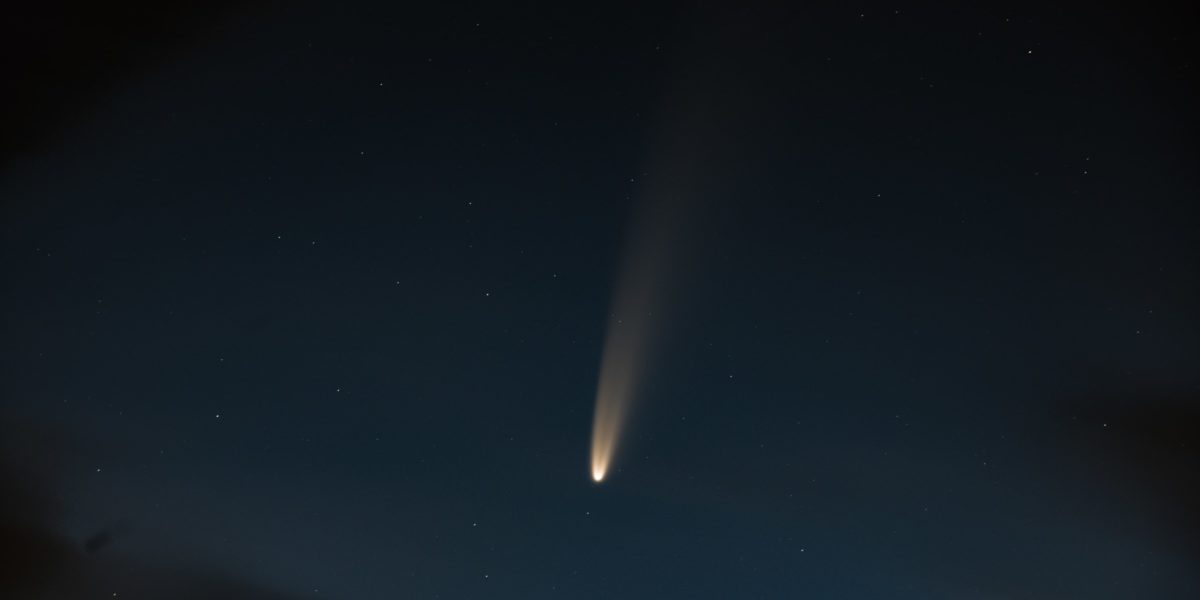
Catch a Comet This July
Will it be as good as Halley’s Comet? No. It should be much better.

Comets aren’t all that rare, scientifically speaking. Our solar system is full of thousands of them. One that can be seen with the naked eye, though—what scientists call a “great comet”—that’s a pretty rare thing. Not since Comet Hale-Bopp in 1997 has there been one easily visible in Western skies.
Residents of the Northern Hemisphere will get another chance this month, though, as comet NEOWISE should be visible without a telescope for the rest of July. (The comet’s all-caps moniker comes from the NASA telescope used to discover the comet this past March, the Near Earth Object Wide-field Infrared Survey Explorer.)
NEOWISE isn’t the easiest thing to spot, but it’s getting easier. Some of you may have been setting alarms to see it in the predawn sky. And you can still do that for a few more days. But starting on the night of July 12, you should also be able to see NEOWISE in the evening as soon as it begins to get dark. Its slow path across the sky—comets don’t streak like meteors, but like the moon, they do change position from night to night—will take it higher and higher above the horizon over the course of about a week.
From July 14 through the 19th, the comet will be about 20 degrees above the horizon in the early evening. In addition, the moon will be a small, not particularly bright crescent during this period, making this window of time a golden opportunity to see the comet. (After the 19th, the comet will get dimmer and lower, becoming slightly more difficult to spot each night.)
Where to Look
To find comet NEOWISE, go to a place with a good view toward the northwest. You’ll want a place with as little light pollution as possible, because NEOWISE will probably only be about as bright as the North Star—visible to the naked eye, but not a blazing beacon. Please remember that you’ll need a place where you can maintain social distancing, as well. As extraordinary as this event is, it’s not worth risking your health or the health of others over.
By about an hour after sunset, the sky should be dark enough to see the comet. Look northwest, toward the constellation Lynx. An astronomy app can help you find this unspectacular, B-list constellation. But if you know the Big Dipper, that’s a good landmark. The dipper’s bowl is located a little to the left of the comet, so start looking from there. Now stick your arms out in front of you and stack your fists on top of each other. Your hands will cover about 20 degrees of sky, so that’s about how high you should be looking. The Sky and Telescope website has a good map showing the celestial location of the comet in July.
What exactly will you see? We can’t say for sure—comets are notoriously unpredictable, and occasionally just phone in their much-hyped appearances—if you remember the 1986 visit by an underwhelming Halley’s comet, you’ll know what I mean. So no promises, but if conditions are good, you may see a point of light with a fuzzy halo around it—that’s NEOWISE. Binoculars will make it much easier to see—try sweeping them slowly across the sky and you may be rewarded with a striking view of the comet’s head and forked tail.
Good, bad, or indifferent, this month is the best chance you’re ever going to have to see NEOWISE, as it will not be back this way for about another 6,000 years.
I’ll be outside in the coming evenings, trying to catch a glimpse and maybe a photo, If you manage to get a good shot, we’d love to see it. Post your photos on social media and tag us on Instagram: @sunsetmag. We obviously can’t all go stargazing together, but we can share this once-in-a-lifetime experience virtually.
